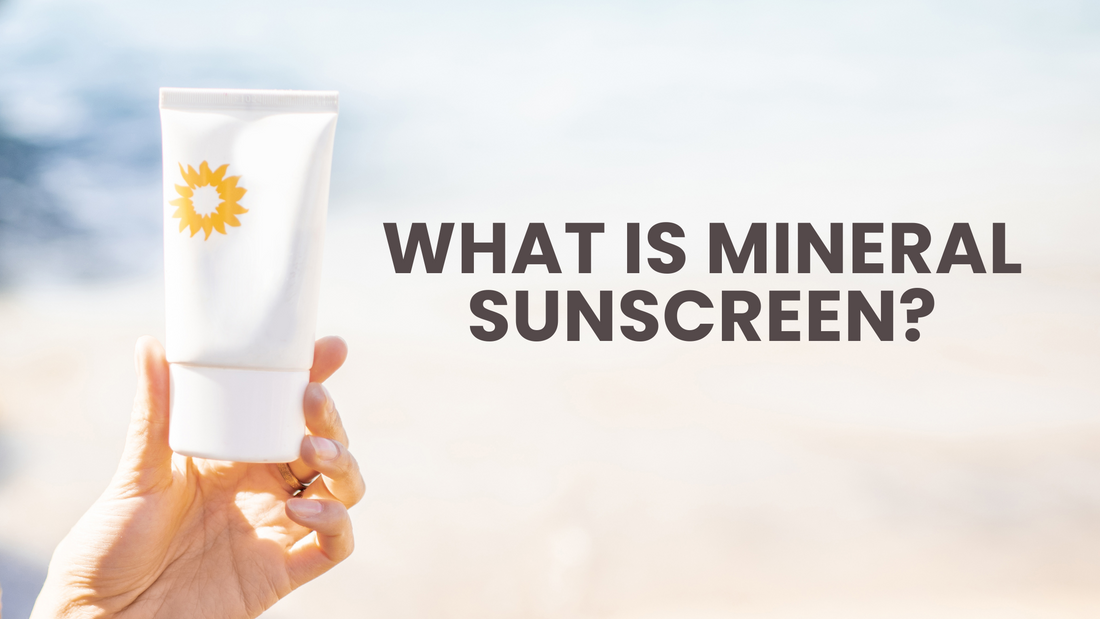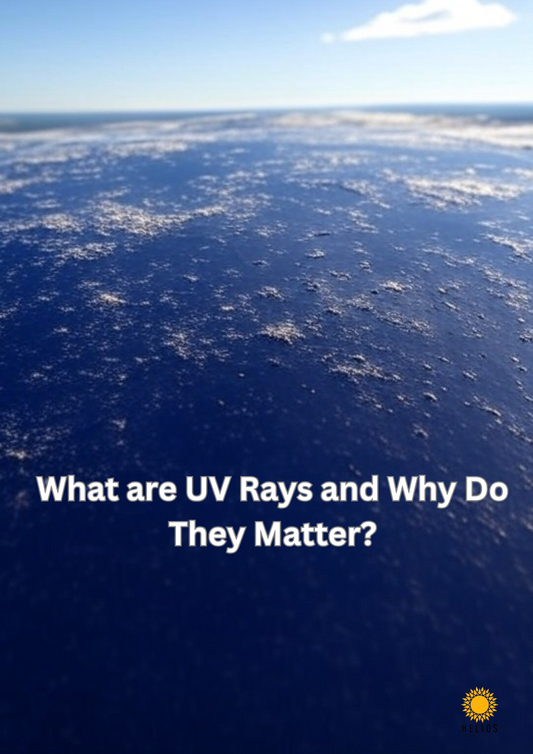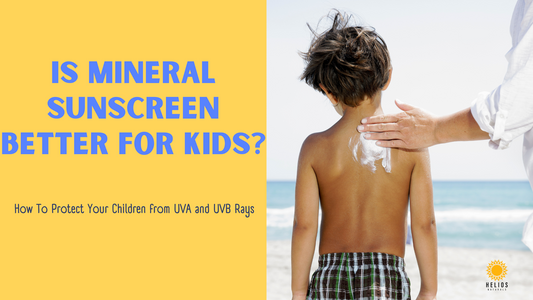
What is Mineral Sunscreen?
Share
When choosing a sunscreen, you’ll notice a lot of terms like physical, mineral, and chemical. It can be challenging to find the right sunscreen to protect you from the sun’s rays.
It’s important to protect yourself from overexposure to the sun, which can result in sunburn, advanced aging, and potential skin cancer risks. To keep your skin healthy, you should find the best type of sunscreen that supports your lifestyle and skin type.
If you’re interested in using mineral sunscreens, it’s important to learn how they protect you from the sun and how they can impact your skin health.
What Are The Basics of Mineral Sunscreen?
Mineral sunscreen is also called a physical sunscreen. Inhibiting exposure from the sun can help minimize your chances of sunburn and lower your risk from developing skin cancer.
Since it doesn’t rely on synthetic chemicals like oxybenzone or octinoxate, mineral sunscreens are less likely to cause skin irritation. Additionally, it’s non-comedogenic which makes it popular for those with oily skin who want gentle sun protection.
Beyond the skin-friendly benefits, mineral sunscreen is highly regarded for its minimal environmental impacts to popular tourist destinations with thriving aquatic life.

Definition of Mineral Sunscreen
A mineral sunscreen is a type of sunscreen that uses zinc oxide or titanium dioxide to create a barrier on the skin that reflects UV rays.
The main difference between the two is that they reflect different UV waves. Zinc oxide and titanium dioxide both reflect UVA and UVB. However, titanium dioxide doesn’t reflect UVA rays as efficiently as zinc oxide.
If you have to choose between them, non-nano zinc oxide gains a slight edge over titanium dioxide.
How Does Mineral Sunscreen Work?
Zinc oxide and titanium dioxide are the active ingredients in mineral sunscreens. These active ingredients create a physical barrier on the skin that reflects UV rays and prevent the skin from getting burned.
What Are The Key Characteristics of Mineral Sunscreen?
According to MDAnderson, an easy tell of a mineral sunscreen is that it leaves chalky, white paste on the applied area. If you can see it on the skin, that means it is working as intended.
Products like these should be reapplied often, especially if you’ve been swimming or sweating. If you don’t like the look of mineral sunscreens, some offer a tinted option that blends naturally with your skin tone.
Mineral sunscreens are also considered safer for marine ecosystems because they do not contain chemicals like oxybenzone or octinoxate.
What Is The Difference Between Mineral and Chemical Sunscreens?

The main difference between them is how they handle the sun's rays, mineral sunscreens create a physical layer of UV protection while chemical sunscreen absorb UV rays and convert it into heat.
While chemical sunscreens may offer convenience, mineral sunscreens are considered safer and just as effective. Mineral based sunscreens do not have the same environmental ramifications as they do not contain irritants since they use minerals which are found in nature.
What Are The Key Differences in Formula?
The key difference between mineral and chemical sunscreens are the ingredients they use in their formulas, mineral sunscreens use minerals that create a barrier on the skin and chemical sunscreens use compounds for sun portection.
Chemical sunscreens use ingredients like oxybenzone, avobenzone, and oxtincate for sun protection factor. Most of these ingredients can remain in the bloodstream after a few days of application and have raised concerns about their endocrine-disrupting effects. Mineral sunscreens rely on minerals such as non-nano zinc oxide and titanium dioxide, which are classified as safe and effective by the FDA.
Chemical sunscreens absorb the sun's rays and convert them into heat within the body while the mineral sunscreens reflect the sun's rays away from the body.
What Are The Pros and Cons of Each Sunscreen?
Mineral sunscreens offer immediate protection once applied to the skin. Chemical sunscreens require at least 15 minutes of shade before sun exposure to be effective.
While chemical sunscreens offer certain conveniences and do not come with an undesirable white cast, they come at a cost to your skin health and harm ecologically sensitive areas.
Mineral sunscreens are generally safe for human use and offer less downside than a chemical sunscreen.
Pros of Mineral sunscreen
- Reef safe, will not harm marine life
- Safe for infants 6 months and older
- Gentle formula for sensitive skin types
- Broad-spectrum protection
- Immediate efficacy
Cons of Mineral Sunscreen
- Potential of visible residue on the skin
- Thicker texture
Pros of Chemical Sunscreens
- Lightweight texture
- High SPF options
- Wait 15 minutes in shade to work
Cons of Chemical Sunscreens
- Skin absorption
- Skin irritant
- Harmful to marine life
- Endocrine disruptors
Safety and Efficacy Comparison
When we talk about chemical sunscreens being toxic to the environment, it can also harm humans too. Research suggests when pregnant women are exposed to oxybenzone, it can lead to a birth defect called Hirschsprung's disease (HSCR). This disease harms the development of nerve cells in the large intestine.
The efficacy of both sunscreens depends on personal preference since they both work well in different ways. Mineral-based sunscreens are immediately effective once applied, chemical sunscreens require application in the shade 15 minutes prior to sun exposure.
What Are The Benefits of Mineral Sunscreen?
Mineral sunscreens are generally suitable for those with sensitive skin, it’s non-comedogenic, minimizes impact on the environment, and offers immediate efficacy.
There are plenty of benefits to using a mineral based sunscreen for sun protection. The hypoallergenic nature of mineral sunscreen makes it suited for those with small children with unparalleled protection against prolonged sun exposure.
Mineral based sunscreens are better suited for those with sensitive skin or those who are concerned about what goes into their bodies and want to protect their environments.
Ideal for Sensitive Skin
Since it sits on top of the skin rather than being absorbed, it is less likely to irritate the skin. The absence of chemicals minimizes the risk of allergic reactions and won’t enter the bloodstream.
Non-nano zinc oxide and titanium dioxide provide sun protection benefits and are also frequently used in creams and lotions to help heal the skin. These minerals also have antimicrobial properties safeguarding against skin infections.
Allergic reactions to Zinc oxide and titanium oxide are extremely rare. These two minerals are marked GRASE (generally regarded as safe and effective) by the FDA.
Safe for The Environment
Mineral sunscreens are 100% biodegradable and eco-friendly. They utilize natural ingredients to protect your skin from sun burn and damage without harming the ocean’s coral reefs.
Chemical sunscreens bleach coral and add more impact to the marine environment, since they do not biodegrade and tend to linger around longer.
If you choose to use a chemical sunscreen, make sure you don’t go swimming near any coral reefs because even without touching them puts them at risk of bleaching and dying.
Suitable for Ages 6 Months and Up
Mineral based sunscreens are suitable for all ages 6 months and up. It’s not recommended for infants under 6 months because their skin is more sensitive.
Babies under 6 months old can’t metabolize or excrete chemicals in sunscreen as well as older children and babies. Which is why it’s best to wait until 6 months to consider applying sunscreen on your child.
When you go outdoors with your infant, it’s crucial to keep them in the shade under an umbrella rather than applying mineral sunscreen.
How to Use Mineral Sunscreen

To apply mineral sunscreen, dab the sunscreen on your finger tips and spread it along the area you want to protect. Then rub the sunscreen so it spreads out, covering the whole area with an even layer.
Whether it’s mineral or chemical sunscreen, it’s only effective when applied properly. Remember if you can see it on the skin, that means it is working as intended
Application Tips
Make sure to cover exposed areas of your skin such as your arms, shoulders, legs, chest, etc. that are not covered by clothing.
If you have trouble reaching certain areas of your body, ask a friend or family member to apply it for you. If you are alone, consider wearing clothing to protect those difficult to reach areas or seek shade.
Reapplication Guidelines
It’s generally agreed that mineral sunscreen should be applied every 2 hours. Especially after swimming or exercising.
Watch for signs of sunburn because once you see the redness on the skin it’s already too late. If you notice your skin feeling warm and tender those are early signs to seek shade and reapply.
How To Choose The Right Mineral Sunscreen

When finding the right mineral sunscreen, it’s important to consider your skin tone and skin type. If you have difficulty finding out your skin type, consult a dermatologist.
Once you have an idea of what your skin tone and skin type is you have to make sure the mineral sunscreen matches with your lifestyle choices. For example, if you exercise, surf, or go swimming, you will want to find a water-resistant formula.
If you aren’t a fan of the white caste mineral based sunscreens are notorious for, some brands offer a tinted version that can match your skin tone.
Key Ingredients to Look For
When choosing the right mineral sunscreen you want to find non-nano zinc oxide or titanium dioxide.
These two minerals are what give mineral sunscreen its sun protection properties. It’s important for the zinc and titanium dioxide to be in non-nano form because it will prevent the ingredients from penetrating the skin barrier.
When choosing a mineral based sunscreen it’s best to avoid the following ingredients: avobenzone, homosalate, oxybenzone, and octocrylene. These ingredients are common in chemical sunscreens that may cause hormone disruption and contain free radicals.
Broad-Spectrum Protection
Broad-spectrum protection means the sunscreen protects against UVA and UVB rays, which are responsible for skin aging and burning.
For many years manufacturers weren’t required to test to label products with broad spectrum protection, until 2011 FDA issued new rules for labeling. This new ordinance required any sunscreen, both chemical and mineral sunscreens, on the market to meet the FDA standards for UVB and UVA protection to be labeled broad spectrum.
Now that the FDA has put measures in place to protect consumers, they can be confident that products with the broad spectrum label offer proportionate coverage to UVB and UVA rays.
Consideration for Skin Types
Most people fall into four buckets of skin types: dry skin, oily skin, sensitive skin, and normal skin.
Luckily, mineral based sunscreens work well for all four types but those with dry skin may want to search for a hydrating formula. Those with oily skin who break out often should opt for a non-comedogenic formula to prevent clogged pores. People with sensitive skin should avoid chemical sunscreens and use mineral sunscreens with titanium dioxide and non-nano zinc oxide.
For those with dry, oily, or sensitive skin it’s recommended to use a mineral sunscreen to limit any unwanted reactions.
What Makes Mineral Sunscreen Water-Resistant?
Beeswax is a great natural ingredient that can be added to sunscreen formulas to make them stick to the skin and less likely to wash off with water.
There are other water-insoluble ingredients like cetyl octanoate and film-forming polymers that provide a residual film to prevent sunscreen from washing off quickly.
Water-resistant formulas are perfect for outdoor activities that involve exercising like swimming. But keep in mind, there is no such thing as a water-proof sunscreen because they will eventually wear off from the liquid.
Does Mineral Sunscreens Harm The Environment?
No mineral sunscreens do not harm the environment because they do not contain any chemicals that negatively react with marine life.
Physical sunscreens are considered safer for the environment because they do not contain ingredients like oxybenzone, avobenzone, and octinoxate that can disrupt marine ecosystems.
These ingredients act as a genotoxicant to coral reefs, meaning it damages the corals’ DNA and ultimately kills their offspring by disrupting the skeletal endocrine.
The main active ingredients zinc oxide and titanium dioxide do not have detrimental effects on coral reefs like chemicals sunscreens do.
What is Reef-Safe Sunscreen

Reef safe sunscreens are mineral sunscreens because they do not impact marine life or cause coral bleaching.
Chemical sunscreens are typically banned from tropical islands because of the effect it has on coral reefs and marine wildlife. Certain ingredients found in chemical sunscreens have raised concerns on marine ecosystems.
On your next vacation, it’s important to take a closer look at the environmental ramifications of the sunscreen you wear and choose an eco-conscious sunscreen to save the environment.
What Is The Environmental Impact of Sunscreen Ingredients?

Active ingredients in chemical sunscreens like oxybenzone and avobenzone can cause damage and bleaching to marine wildlife.
Several states in the United States have banned chemical sunscreens to protect marine life and coral reefs. Hawaii became the first state to ban the sale of sunscreens containing oxybenzone and octinoxate, two chemicals known to damage coral reefs.
These legislative measures aim to provide safeguards to protect marine environments by reducing the harmful effects of chemical sunscreens. By implementing legislation, they take proactive measures to ensure reef-safe mineral sunscreens are used in their waters.
Should You Use Mineral Sunscreen?
For the eco-conscious consumer, it seems like an easy decision to make. Selecting the right sunscreen involves considering factors like SPF level, water resistance, and application preferences.
Mineral sunscreen offers broad-spectrum protection and is suitable for those with sensitive skin types. While chemical sunscreens may be enticing for their light weight, non-greasy formulas may come at a cost to the ecosystem and potentially health risks.
Check the ingredients list to make sure the mineral based sunscreen has non-nano zinc oxide or titanium dioxide as active ingredients as they are considered safer for your skin health and the environment.



